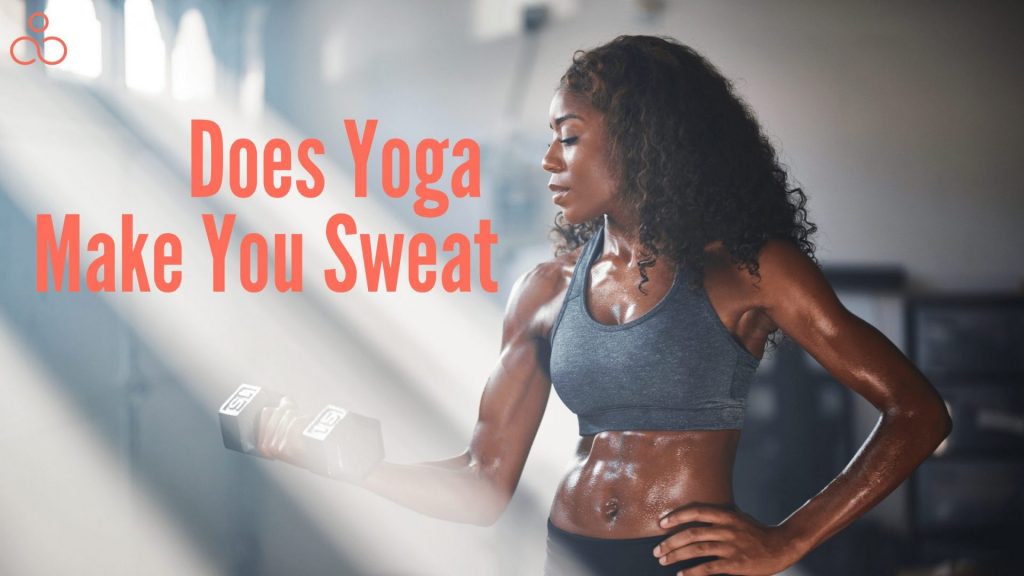You’ve seen it everywhere – in parks, studios, and even online classes. What is this craze all about? Yoga! But have you ever wondered, “Does yoga make you sweat, and if so, is it beneficial or detrimental to our well-being?”
In this article, we’ll dive into the connection between yoga and sweating, exploring whether this ancient practice leaves you drenched or merely glowing and how it affects our overall wellness.
So, get ready to challenge your assumptions and discover how this serene yet powerful discipline can transform both your body and mind.
Does Yoga make you sweat? If yes, then, what does sweating in Yoga actually mean?
Sweating in Yoga results from intense breathing, heat, and hard work. It signifies dedication and persistence through challenges. Active pursuits like Yoga enhances well-being throughout life due to physical exertion and focused breathwork. Heated rooms can aid muscle flexibility, but they aren’t necessary for all practitioners. Heat-acclimatized yogis often enjoy the benefits of a warm practice space.
Sweating cleanses our skin, and helps regulate body temperature and blood pressure, with variations by age and gender. Increasing internal body heat and adapting to it can be achieved through deep breathing and movement. Regulating body temperature during exercise is crucial to avoid dangerous hyperthermia. Thermoregulatory adaptations depend on heat type and cardiovascular adjustments.
To fully experience the cleansing effects of heat, maintaining consistent breathing patterns and fluid movements is vital. Practitioners who achieve proper heat balance can enjoy increased self-regulation, connection with others, peace, resilience, flexibility, and clearer communication without defensiveness.
Why does Yoga make you sweat so much?
In contrast to intense exercises, Yoga doesn’t cause much sweating. However, some people still sweat a lot during Yoga, and here’s why.
- Sweating occurs when the body heats up due to exertion and aims to cool down. If Yoga heats your body, you’ll likely sweat.
- Longer workout sessions lead to more sweating. So, during extended Yoga sessions with simple, slow-paced moves, you may still sweat.
- For beginners, Yoga can be demanding and cause sweating due to unfamiliar stress on the body. Despite seeming easy at first glance, your body might not be accustomed to the exertion of Yoga, causing you to heat up and sweat quickly for cooling down.
Why Is It Completely Normal to Sweat While Doing Yoga?
Many new yogis think, “I shouldn’t sweat. It’s just Yoga.” But sweating is actually good!
Even during gentle Yoga sessions, some sweat is normal. Yoga is a detoxifying exercise, including various bends, twists, balances, and stretches. These movements help release toxins from your body through sweat. So remember, sweating during Yoga is not only okay but healthy too!
Boost your immunity
As your body heats up and starts perspiring, it experiences an internal response similar to having a fever, as though it’s combating an infection. Consequently, your body generates more white blood cells – the ones responsible for bolstering immunity and fighting off illnesses or diseases entering your system. Combining this process with the expulsion of toxins from your organs through perspiration essentially contributes to improving your overall health.
Improves your heart health
Sweating during Yoga signifies that your body is putting in effort. Regardless of whether you are short of breath, your heart is working harder. As your internal temperature escalates, your body has to cool down. One method it employs is sweating. Your heart rate rises to facilitate the circulation of fluids necessary for exiting through your pores and cooling your body. It’s truly astonishing.
Your heart, a muscle, becomes stronger with exercise, just like other muscles. It may pump vigorously to supply more oxygen (as during an intense yin Yoga flow) or to expel toxins and regulate body temperature. Still, either way, sweating implies the heart muscle’s strengthening.
Improves skin health
In case you weren’t aware, consistent Yoga practice is a guaranteed method to alleviate numerous skin issues. If you suffer from hormonal acne, psoriasis, or eczema. Yoga can provide relief. Furthermore, Yoga has been scientifically proven to lower stress levels and decrease inflammation, which are both significant contributors to skin problems.
Apart from that, sweating during Yoga effectively removes toxins that could be causing skin issues while also providing anti-aging benefits. Who wouldn’t want more youthful and healthier-looking skin? Go ahead and raise your hand. The truth is that sweating also results in increased blood flow to the surface of your skin. This blood carries essential oxygen and nutrients that promote your skin’s health and vitality.
Boost in brain health
Although this information is relatively recent, engaging in sufficient activity to cause a light sweat is beneficial for your brain, particularly in older individuals. Researchers have found that physical exercise genuinely enhances brain health. Yoga, being one of the safest activities that anyone can participate in, makes us strong supporters of incorporating it into your routine to “sweat it out” and promote a healthier mind!
Releases toxins
Studies indicate that toxins get eliminated from the body through perspiration, similar to how they are excreted during urination. Sweating also discharges insignificant quantities of heavy metals and substances like BPA (present in plastics) and PCBs (found in adhesives, plastics, electrical equipment, and numerous other everyday items). Since Yoga directly aids in expelling toxins from your internal organs, it follows that perspiring while engaging in Yoga, regardless of the intensity or simplicity of the practice, is undoubtedly beneficial.
A Sweat-Inducing Yoga Routine For A Healthy Lifestyle
Immerse yourself in this powerful Vinyasa Yoga session to revitalize your body and mind.
Sun Salutation A (Surya Namaskara A)
Inhale, lift your arms overhead, hands together, and look at your thumbs. Exhale and bend forward, reaching for legs or feet, looking at toes. Keep knees slightly bent if needed. Inhale, raise the torso, and gaze, extending the spine. Exhale, step, or jump back to plank, lower to chaturanga with elbows close, and gaze forward. Inhale, straighten arms, point toes, look up, and lift into an upward dog or modify with kneeling plank and low cobra. Exhale into a downward-facing dog; stretch your spine; hold for five deep breaths. Inhale to walk or jump feet forward; lengthen the spine; raise gaze. Exhale and fold again. Inhale to raise arms high overhead with palms touching; look at thumbs. Exhale and lower arms for Samasthiti before the next Sun Salutation. Repeat 3 to 5 times.
Sun Salutation B (Surya Namaskara B)
Inhale, sit in chair pose, raising arms and looking at thumbs. Keep weight in heels and toes visible. Exhale, and fold forward towards your knees. Inhale, and straighten the spine. Exhale to plank, and perform chaturanga. Inhale into an upward dog. Exhale into downward dog.
Inhale, right foot forward in warrior A pose. Exhale into plank and chaturanga. Inhale to upward dog, exhale to downward dog. Now left foot forward in warrior A. Exhale to plank, chaturanga, upward and downward dog.
Stay in downward dog for five breaths. Inhale to walk feet forward and straighten the spine. Exhale to fold forward. Inhale to chair pose and exhale to Samasthiti position. Repeat the Sun Salutation B sequence 3-5 times.
Plank/Downward Dog/Lunge Sequence
Inhale and lift both arms, hands joined, looking at thumbs. Exhale, bend forward, and touch your lower legs or feet, eyes on toes. Inhale, lift your torso a bit, gaze up, and stretch your spine. Exhale, step/jump to plank and inhale. Exhale into downward dog. Inhale, step right foot forward into a lunge, left heel up. Exhale, hands on either side of the foot. Inhale to plank. Exhale to downward dog. Repeat steps 4-10 (3-5 times). Move to the next phase from downward dog. Inhale, jump/walk feet forward, stretch spine, raise gaze. Exhale, and bend forward towards the toes. Inhale, slightly bend knees, lift arms overhead with palms touching, and look at thumbs. Exhale, lower arms beside the body in Samasthiti.
Extended Triangle (Utthita Trikonasana)
Move your left foot back and angle it 45 degrees outward. Keep your right foot facing forward and straighten your legs. Breathe in, raise your arms to the sides like tree branches, then tilt and twist your body so your left-hand faces the sky and your right-hand touches the inside of your lower leg or foot. Keep your shoulders aligned and make space between your shoulder blades. Hold this position for five deep breaths.
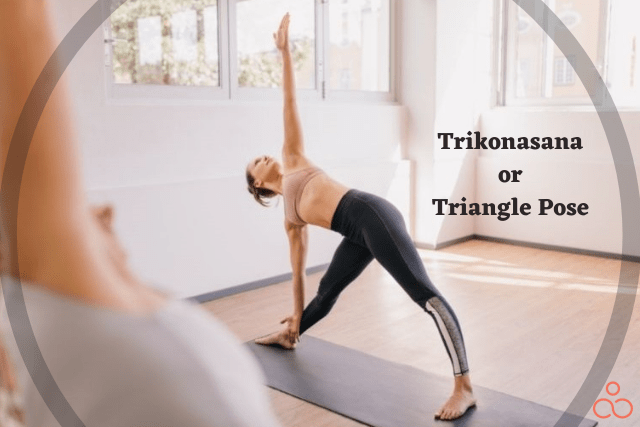
Revolved Triangle (Parivritta Trikonasana)
Swing your arms down, placing your left hand inside your lower right leg/ankle. Reach your right arm up towards the sky while elongating your upper body muscles, especially the neck. Hold this position for five deep breaths. Move to the front of your mat and perform extended and revolved triangle poses with your right foot back, holding each pose for five breaths. Return to the mat’s front with feet side by side. Optionally, do a vinyasa (like Sun Salutation A but with a one-breath downward-facing dog) before continuing to the next pose.
Side Angle Pose (Utthita Parsvakonasana)
Breathe in and step back with your left foot, turning it 45 degrees forward. Spread your arms like branches. Lunge by bending your right leg until the knee aligns with your ankle. Rest your right forearm on the thigh without putting too much weight. Keep some space between the shoulder and ear. Rotate your left side upwards and stretch your left arm overhead for a strong stretch from the triceps to the waist. Keep both feet firmly grounded. Maintain this position for five deep breaths.
Revolved Side Angle Pose (Parivritta Parsvakonasana)
Breathe in and lift your upper body, leaving the side-angle pose. Join your hands and turn to the right, possibly resting your left elbow on your right thigh while pressing your palms toward your chest. Feel solid and stable on all four corners of your feet. Stay here for five deep breaths. Next, step forward with your left foot and perform side angle and revolved side angle poses with your left foot leading. Hold each pose for five breaths before stepping to the mat’s front. You can choose to do a vinyasa before moving to the next pose.
Wide Legged Forward Bend Pose (Prasarita Padottanasana A)
Take a deep breath and make a quarter turn to your right, either by jumping or stepping. Spread your feet wide for a comfortable stretch in your inner thighs. Point your toes straight ahead, towards the mat’s side. Inhale, putting your hands on your waist. Exhale, bending forward and placing hands shoulder-width apart on the floor or a block, aligned with your toes. Focus on expanding your chest and extending from the base of your spine up to the head’s top. Prevent hunching your upper back or lowering your head. Keep legs engaged for stability in this pose, distributing weight evenly across your feet without gripping toes. If you feel any discomfort in the back of your knees, try bending them slightly. Hold this position for five deep breaths.
Wide Stance Intense Stretch Posture (Prasarita Padottanasana C)
Inhale, and gently stand up straight. Interlock your fingers behind you (or press your palms together) and open your shoulder sides by bringing your shoulder blades closer. Exhale, and slowly bend from your hips, with your torso and linked arms extending forward. Focus on expanding your chest and stretching from the base of your spine to the top of your head as you lean forward. Avoid hunching or dropping your head. Keep your legs engaged for a stable base. Balance your weight evenly on your feet without gripping your toes. Slightly bend your knees if you feel discomfort at the back of them. Inhale, rise up slowly, exhale as you release your hands, return your feet forward, and step or jump back to the mat’s front.
Chair Pose (Utkatasana)
Begin in mountain pose, feet close or slightly apart, and toes pointing forward. Spread your toes and feel grounded on both feet. Gently sit back as if an invisible chair is behind you, trying to make your thighs parallel to the floor. Lift your arms, palms facing inward, and relax your shoulders away from your ears. Look at your hands, shifting weight onto your heels while keeping your knees above your toes. Ensure you can see your toes in front of your knees. Engage your hamstrings to prevent back arching. Hold this pose for five deep breaths.
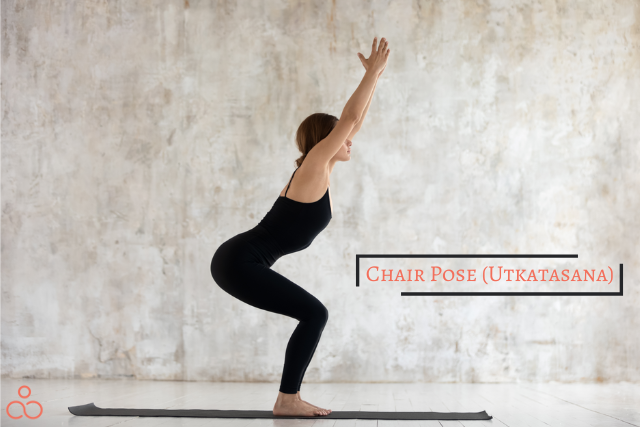
Warrior Posture (Virabhadrasana A)
Step back with your left foot into Virabhadrasana A. Bend your right leg so the knee is above the ankle, with your right foot pointing forward and left foot at a 45-degree angle. Raise your arms overhead, stretch your spine, and press all four corners of both feet into the ground, focusing on the outer edge of the left foot. Keep your pelvis facing front and engage upper posture muscles. Look up at your thumbs or slightly higher, and hold for five deep breaths.
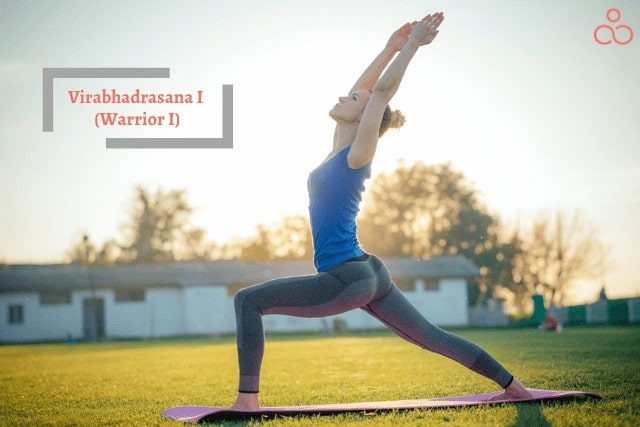
Warrior Posture (Virabhadrasana B)
Shift into Virabhadrasana B, turning your left toe outward and stretching your arms like tree limbs, level with the ground. Keep your front leg bent at 90 degrees, making sure your knee doesn’t extend past your ankle. Focus on your right middle finger. Align your shoulders over your hips and gently tilt your pelvis to ease lower back pressure. Firmly plant both feet, feeling secure and connected to the earth.
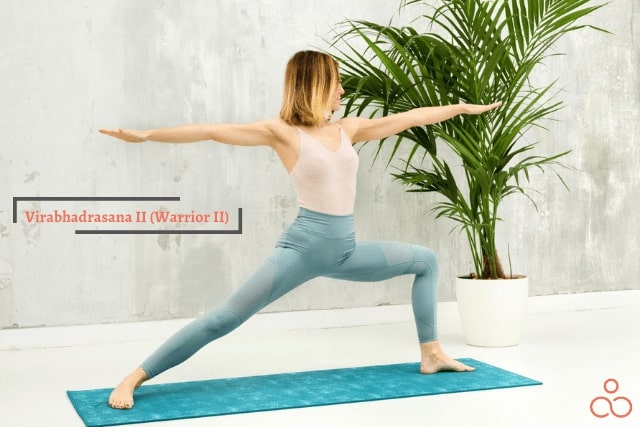
Reverse Warrior (Viparita Virabhadrasana)
As you lower your hands, reverse the warrior pose, keeping a 90-degree angle in your front leg. Place your left hand on the back of your left thigh, and raise your right arm backward and towards your left leg until your biceps are near your right ear. Feel the right side-body stretch and stay in this position for five deep breaths. When you’re done, inhale and bring your arms to the side of your body. Exhale and take a step forward to the front of your mat. Repeat the three warrior poses, but this time step back with the right foot and have the left foot lead the way.
Did you know?
While Yoga offers numerous health benefits, it’s not accurate to say that sweating during Yoga is entirely beneficial. Here’s why.
- Yoga texts advise against excessive sweating to prevent Ojas (energy loss).
- Traditional and Chinese medicine warns of overheating risks.
- Excess heat can lead to injury, dependence, aging, and health issues.
- Excess heat can cause weakness, skin problems, and bad odor.
- Over-sweating opposes Yoga’s principles of life force preservation and inner balance.
- Sweating without a heat source might signal the need for a doctor’s checkup.
10 Best Ways to Deal with Excessive Sweating During Yoga
Sweating can be a love-hate relationship. On one hand, we embrace its health benefits during exercise. On the other hand, we hate the sticky feeling of carrying a drenched Yoga mat or wearing a clingy, wet shirt. It seems like no one enjoys that, right?
So, what’s the solution?
1. Don’t panic
Don’t worry, you’re not alone in sweating during Yoga – it’s totally normal! Instead of stressing and sweating more, embrace it and keep going. Enjoy your practice!
2. Wear breathable, loose-fitting clothing
Tight shirts that fit snugly beneath your arms might cause stubborn underarm sweat stains. Not to mention, they can make you sweat more, too.
To avoid this, wear fabrics that are breathable and choose clothes that fit more loosely. This way, your underarms won’t overheat and you won’t have to worry about sweat and stains ruining your shirts.
3. Bring a towel
It’s simple! Don’t expect the studio to supply everything. If your instructor offers adjustments, keep an extra towel just for them. This way, you’ll feel more at ease, and they’ll be more likely to help.
4. Grab a Yoga strap
Things aren’t looking great. You forgot your towel, your shirt is drenched, and flipping the mat didn’t help! Your hands are slipping like two furious oil wrestlers.
Time for a quick solution: Grab a Yoga strap and place it a few inches from the top edge of your mat. In downward dog, position your palms below the strap and knuckles above it. It’s not fancy, but it’ll surely rescue your slippery Yoga session.
5. Use your own equipment
Rolling in someone else’s sweat may feel gross. Having your own mat offers hygienic and better performance. Ditch the slippery borrowed mats and upgrade to a high-quality, non-slip mat, enhancing your practice experience.
6. Use topical antiperspirants
Fed up with shirt sweat stains? Swap your regular deodorant for antiperspirant. Deodorant tackles odor but doesn’t stop sweating. Antiperspirants eliminate bacteria and block sweat glands, reducing discomfort.
If standard antiperspirants fail, try stronger ones with at least 13% aluminum chloride. If still unhelpful, consult a doctor for a prescribed version.
To maximize effectiveness:
- Apply on clean, dry skin.
- Use at night after bathing for the best results.
- Shave underarms but don’t apply immediately after, as it may irritate the skin.
- Be patient; it can take up to 4 days for full effect.
7. Avoid sweat-inducing foods
Did you know your diet affects your sweat levels? Certain foods make you sweat more than others. To combat excessive sweating, try cutting out sweat-triggering foods. Low-fiber foods strain your digestive system, while high sodium intake leads to detoxing through sweat and urine. Plus, high-fat foods warm your insides as your body breaks down the fat.
Watch out for these sweat-inducing foods and beverages:
- Processed foods
- Alcohol like liquor and beer
- Garlic and onions
- High-fat content foods
- Caffeine
- Spicy dishes
- Ice cream
8. Eat more foods that reduce sweat
Certain foods can help cut down sweat and soothe overactive sweat glands.
To combat sweat with your diet, pick foods that are easy to digest and won’t trigger your nerves but calm them instead.
Try adding these sweat-fighting foods:
- water
- high-calcium options (like dairy and cheese)
- almonds
- bananas
- whey
- high-water content fruits and veggies (e.g., watermelon, cantaloupe, grapes, broccoli, cauliflower, spinach, bell pepper, red cabbage, eggplant)
- olive oil
- oats
- green tea
- sweet potatoes
9. Skip the caffeine
Consuming caffeine can put a strain on your nervous system and cause excessive sweating. It raises your blood pressure, increases your heart rate, and activates your sweat glands.
If you’re someone who loves coffee or other hot drinks that contain caffeine, you may experience even more sweating. Hot beverages increase your body temperature and bring on extra perspiration. To avoid this, try reducing or eliminating caffeine from your diet.
10. Stop smoking
Nicotine, like caffeine, increases your body temperature, accelerates your heartbeat, and activates your sweat glands.
Smoking can also be detrimental to your oral hygiene and health, contributing to bad breath, yellow teeth, and even cancer.
If you’re looking to reduce sweat and improve your well-being, quitting smoking could be the way to go.
FAQ’s
Is it normal to sweat during Yoga?
Yes, it is normal to sweat during Yoga. Sweating during Yoga means your body is working hard. Even without feeling breathless, your heart pumps faster. As your inner temperature goes up, your body cools down by sweating.
Why do I sweat so much in hot Yoga?
Sweating is the body’s natural way of cooling down, so don’t worry about a sweaty shirt after Yoga. Everyone sweats differently due to factors like sweat glands, temperature, exercise intensity, genetics, body weight, water intake, and anxiety levels. Sweating during a workout shows good physical fitness.
To stay safe in hot Yoga studios: drink cold water regularly; have electrolyte-rich sports drinks after class; rest or leave the studio if feeling unwell; and cool down with a cool shower and fan.
Important: If you experience excessive sweating or no sweating, consult your doctor for conditions like hyperhidrosis or anhidrosis.
Does hot Yoga make you sweat at night?
Yes, hot Yoga can make you sweat at night. This is mainly due to the increased body temperature and perspiration experienced during a hot Yoga session. As the body works to cool itself down after the practice, it may continue to produce sweat, even at night. Additionally, hot Yoga can stimulate the sweat glands, making them more reactive and leading to increased sweat production during sleep.
Does Hatha Yoga make you sweat?
No. You won’t work up much of a sweat in a Hatha Yoga session, but you will feel a difference in your body. After the class, you should feel more stretched, more relaxed, and rejuvenated.
However, depending on the intensity of the practice and the individual’s body response, sweating may occur.
What causes excessive sweating?
Excessive sweating happens when nerves signal sweat glands without heat or exercise, making them overly active. It may be hereditary, but the exact gene is unknown.
Some medical issues like heart disease, menopause, stroke, hyperthyroidism, and cancer cause sweating too. It can also be a side effect of medications.
Talk to your doctor if you think you’re experiencing excessive sweating from a medical condition or medication.
Does sweating burn calories?
No, that’s not necessarily the case. Sweating a lot can indeed indicate you’re exerting yourself, using up more energy, but that doesn’t mean you’re burning more calories. Factors like sweat gland activity primarily contribute to the amount of sweat produced.
Conclusion
Yes, practicing Yoga can indeed make you sweat, depending on the intensity and style of practice you choose.
As we’ve explored, hot Yoga is a surefire way to work up a sweat, while other disciplines such as Vinyasa or Ashtanga can also deliver quite a workout. Incorporating Yoga into your daily routine not only helps improve your flexibility and balance but also promotes mental well-being.
The next time you roll out your mat, embrace the sweat as a sign of progress and transformation. After all, breaking a sweat is a small price to pay for the countless benefits Yoga brings to our lives. Just remember to keep yourself hydrated and not overdo it.

